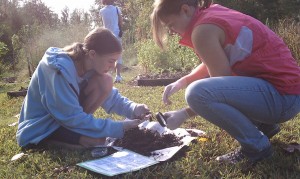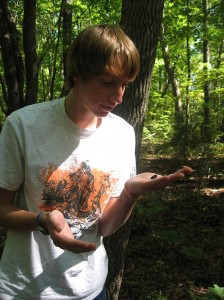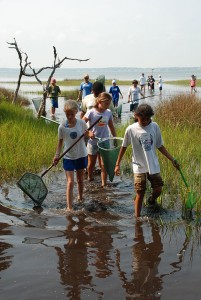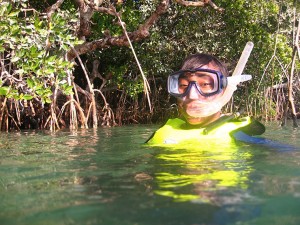By KATHRYN STEVENSON
EDITOR’S NOTE: Kathryn Stevenson is a doctoral student with the Fisheries, Wildlife & Conservation Biology program at North Carolina State University. She worked for two years as a marine science instructor on Catalina Island in California. She also spent six years in the classroom as a high-school biology teacher before coming back to graduate school. Stevenson’s dissertation research includes the studies discussed in this article.
“Did you see that fish?!!” the 15-year-old girl exclaims. Her eyes are as big as saucers through her face mask.
Her nervousness of being in the ocean forgotten, the Chapel Hill native from Woods Charter School splashes her face back in the water, still squealing with glee through her snorkel. Back on shore, she excitedly compares her list of fish, snails and algae with those of her classmates.
Not all outdoor education experiences involve getting wet. But students learn while having fun — snorkeling, hiking, canoeing, walking in the woods, beachcombing, you name it. More than the simple enjoyment that these activities provide, outdoor education is an important component in learning about the environment.

An environmentally literate citizen is better equipped to address complex environmental issues. Photo by Kathryn Stevenson.
Research led by scientists from North Carolina State University, and funded by North Carolina Sea Grant, surveyed middle-school teachers and students, and their respective schools. The team found that teacher training and experience is the most important factor in building environmental knowledge among students. Learning in an outdoor environment and from established environmental education curricula also improves environmental literacy.
In addition, the researchers gained some insight into how students of different ages and genders learn — and how outdoor education may be particularly effective with minority students.
The benefits of taking kids outdoors — improving learning, connecting them with nature — have been getting a lot of attention lately at local and national levels.
And teachers are pleased that others are taking notice.
“Exposing students to the outdoors as a regular part of the curriculum improves metacognitive skills and engages students in the meaning of what they are learning,” says Stuart Miles, lead seventh- and eighth-grade science teacher at Evergreen Community Charter School in Asheville. Metacognitive skills refers to students’ awareness of what they know and ways they can learn best.
“Moreover, it impresses a respect for and engagement with the natural world, which leads to behaviors as children and adults which help conserve and protect the environment,” he adds.
ENVIRONMENTAL LITERACY
Achieving environmental literacy is a critical step in addressing emerging environmental problems.
Researchers at NC State, North Carolina Central University and Middle Tennessee State University are identifying factors that build environmental literacy in North Carolina students.

Researchers discovered complementary strengths between boys and girls. Photo by Kathryn Stevenson.
The team initially conducted a statewide survey of middle-school students and teachers to determine the current level of environmental literacy among students and what factors help develop that knowlege. The researchers developed the study with input from colleagues at the N.C. Department of Public Instruction and the N.C. Office of Environmental Education and Public Affairs.
“This is one of the first studies on a broad scale to focus on environmental literacy which is more than mastering facts,” says Nils Peterson, an NC State College of Natural Resources faculty member, who led the Sea Grant-supported work.
“Being environmentally literate means that students learn cognitive skills so that they can analyze and solve problems, and it involves environmental attitudes and behaviors as well,” he adds.
“Studies such as this one are needed to provide data to support other research and what we’ve observed anecdotally for a long time — when teachers use environmental education methods, resources and curricula, students score higher on measures of environmental literacy and perform better academically,” says Lisa Tolley, environmental education program manager for the N.C. Office of Environmental Education and Public Affairs, noting another valuable contribution from this work.
“This study supports recommendations in the N.C. Environmental Literacy Plan for integrating environmental concepts in multiple disciplines, creating outdoor learning environments on school grounds, taking students on field trips and supporting teacher professional development,” she adds.
Within the environmental education field, environmental literacy is commonly defined to include:
- Ecological Knowledge: Understanding concepts such as energy flow, habitats and nutrient cycles.
- Environmental Affect: Developing environmental attitudes, environmental sensitivity and inclination toward environmentally friendly behavior.
- Cognitive Skills: Building the ability to identify and analyze environmental problems, and come up with an action plan.
- Environmental Behavior: Taking action to protect the environment.
“Environmental literacy has been identified by the Partnership for 21st Century Skills as a key theme to be woven into core subjects in 21st century learning,” explains Frank McKay, former eighth-grade science teacher at Exploris Middle School in Raleigh. Adopted in North Carolina in 2006, the Partnership for 21st Century Skills emphasizes creativity and innovation, critical thinking and communication.
“As a middle-school teacher, I have found this not only to be an important goal in my teaching, but also a strategy to motivate student learners,” McKay says.
North Carolina and the federal government also are paying attention to students’ environmental knowledge. In July, a bipartisan bill reintroduced the No Child Left Inside Act to strengthen environmental education and connect kids with nature. If passed, the federal legislation, which was first proposed in the previous decade, will offer states funding to support environmental and outdoor education efforts.
To be eligible for the funding, states must prepare an Environmental Literacy Plan, or ELP. North Carolina’s ELP was developed by a group of environmental education specialists, representatives from the N.C. Office of Environmental Education and Public Affairs and classroom teachers.
“A state environmental literacy plan will provide guidance for teachers and school systems that want to produce students who understand the complexity of environmental issues and can make sound decisions while balancing the economy, cultural perspectives, public health and the environment,” explains Tolley, who also serves on the ELP workgroup.
Teachers are encouraged to use the ELP as a resource for building environmental literacy among their students, she adds.
“The Curriculum and Instruction Division plans to continue to collaborate with our colleagues at the N.C. Department of Environment and Natural Resources, and provide support to teachers as they learn about the ELP,” says Beverly Vance, who leads the science portion of the K-12 Curriculum & Instruction Division for the N.C. Department of Public Instruction.
ACHIEVING ENVIRONMENTAL LITERACY
The researchers surveyed middle schools, teachers and classrooms in North Carolina, with a focus on sixth and eighth grades.
They compared schools with and without environmental programs, based on their registration records with the N.C. Office of Environmental Education and Public Affairs. Teachers in the selected schools filled out questionnaires to report on use of environmental education curricula, class time spent outdoors, and their own training and experience. The researchers administered two surveys to students — a pretest in January 2012 and a post-test that spring — to determine their baseline knowledge and improvements in their environmental literacy over one semester.

Researchers noted that teacher training and experience is the most important factor in building students’ environmental knowledge. Photo by Kathryn Stevenson.
“The study supports existing research that environment-based learning can improve environmental literacy, increasing a student’s ecological knowledge and cognitive skills,” Tolley explains.
Based on their results, the team identified some ways to build environmental literacy through schools:
Use published environmental education curricula. Several agencies and organizations have developed curricula for teachers that include background information, engaging activities and materials, which align with state and national standards. The study shows that these curricula work. Students exposed to the materials improved their cognitive skills more than those who were taught without these guides. Because cognitive skills is by far the weakest criterion in environmental literacy in the state, using these trusted curricula is particularly important. The most popular curricula include Project Learning Tree, Project WET and Project WILD — focusing on forests, water-resource education and wildlife, respectively.
Take students outside. As teachers such as Miles and McKay know, and as the snorkeling teenager discovered, outdoor activities provide unique learning opportunities. Students who went outside as part of classes scored higher on three of the criteria that define environmental literacy — ecological knowledge, affect and behavior — than those who did not.
More effective, though, was a combination of using established curricula in conjunction with outdoor activities. Together, these two elements enable students to improve in all four areas of environmental literacy.
Support teacher training and continued professional development. The researchers also found that the most important factor in building environmental literacy among students is having a teacher with a master’s degree. Also, teachers with three to five years of experience are the most effective — more so than brand-new teachers and even teachers with more than five years of experience. Researchers found that students taught by those teachers improved more over the semester than students of more or less experienced educators.
Building environmental literacy is a big task, and schools need experienced, well-trained teachers to lead the effort. In addition, schools need to offer professional development opportunities and support to their more experienced teachers in order to maintain the educators’ commitment to environmental education.
Recognize differences among students and work to raise environmental literacy for all. From the administered tests, the researchers found that boys and girls seem to have complementary skills. Boys have higher ecological knowledge, while girls have higher affect and cognitive skills.
Teachers need to figure out how to encourage boys and girls to learn from each other. Younger students improve in environmental literacy faster than older ones, which means educators must determine how to keep the older students engaged.
Further, the survey showed that African American and Hispanic students had lower initial knowledge and cognitive skill levels than Caucasian students. The researchers noted that outdoor education might close that gap. Time outdoors during class time seems to have a greater impact on African American and Hispanic students than Caucasian ones, leading to increased improvement in knowledge and environmentally sensitive behavior over the semester.
ADDRESSING LARGER ISSUES
Understanding how to build environmental literacy through schools is just one thing the researchers are working on. With help from Sea Grant, these scientists are trying to learn how to ensure students are equipped to tackle environmental challenges, such as climate change and fracking, as adults.

Outdoor class activities can introduce students to new experiences that can help them learn. Photo by Kathryn Stevenson.
“There are all these huge environmental issues we’re trying to deal with,” NC State’s Peterson says. “If we as a society are going to be able to address some of these issues, we’re going to need a public that is able to understand these complex phenomena.”
The researchers also are looking at what factors outside of school contribute to environmental literacy. So far, they have found some evidence that kids who spend time outdoors alone or with family have higher levels of environmentally friendly behavior. Having an adult role model also seems to help.
Another way to improve environmental literacy lies in turning off the television.
Watching even nature-related television was linked to lower levels of ecological knowledge. This point reflects research from other scientists that shows increased exposure to technology is hurting kids’ connection to nature.
This fall, the team will start looking at how to increase environmental literacy around climate change. They will begin by holding focus groups with middle-school teachers to learn more about how teachers currently address the topic and how they might best be supported.
Separately, researchers are seeking funding to build a climate change curriculum and continue surveying students to learn how to best prepare future generations to mitigate and adapt to climate change.
Laurell Malone, one of the project researchers, sees value in environmental learning for all students, coastal or inland.
“We do have inner-city kids who live around lakes and rivers that can also benefit from this information,” explains Malone, who chairs the Department of Educational Leadership at NCCU.
“Just because they’re not on the coast now does not mean they will not be some time.
Having that literacy and climate and environmental education is going to make them productive citizens and informed citizens.”
To read the academic paper from this study, visit www.plosone.org and search for “Stevenson, Kathryn.” Go to www.eenorthcarolina.org/NCSU Environmental Literacy Fact Sheet Final 1.pdf for a one-page summary of the findings.
North Carolina’s Environmental Literacy Plan is available at www.eenorthcarolina.org. Under Resources, select “Pre K-12 Environmental Literacy Plan.”
Follow the progress of the No Child Left Inside Act using its bill numbers — S. 1306 in the U.S. Senate and H.R. 2702 in the U.S. House of Representatives.
This article was published in the Autumn 2013 issue of Coastwatch.
For contact information and reprint requests, visit ncseagrant.ncsu.edu/coastwatch/contact/.
